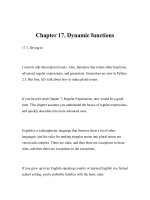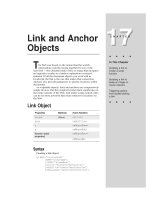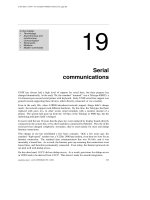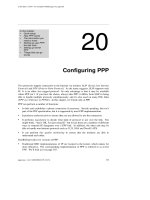Chapter 17: Transport Protocols ppt
Bạn đang xem bản rút gọn của tài liệu. Xem và tải ngay bản đầy đủ của tài liệu tại đây (404.7 KB, 60 trang )
William Stallings
Data and Computer
Communications
Chapter 17
Transport Protocols
Connection Oriented Transport
Protocol Mechanisms
❚
Logical connection
❚
Establishment
❚
Maintenance termination
❚
Reliable
❚
e.g. TCP
Reliable Sequencing Network
Service
❚
Assume arbitrary length message
❚
Assume virtually 100% reliable delivery by
network service
❙
e.g. reliable packet switched network using X.25
❙
e.g. frame relay using LAPF control protocol
❙
e.g. IEEE 802.3 using connection oriented LLC
service
❚
Transport service is end to end protocol
between two systems on same network
Issues in a Simple Transprot
Protocol
❚
Addressing
❚
Multiplexing
❚
Flow Control
❚
Connection establishment and termination
Addressing
❚
Target user specified by:
❙
User identification
❘
Usually host, port
•
Called a socket in TCP
❘
Port represents a particular transport service (TS) user
❙
Transport entity identification
❘
Generally only one per host
❘
If more than one, then usually one of each type
•
Specify transport protocol (TCP, UDP)
❙
Host address
❘
An attached network device
❘
In an internet, a global internet address
❙
Network number
Finding Addresses
❚
Four methods
❙
Know address ahead of time
❘
e.g. collection of network device stats
❙
Well known addresses
❙
Name server
❙
Sending process request to well known address
Multiplexing
❚
Multiple users employ same transport protocol
❚
User identified by port number or service access
point (SAP)
❚
May also multiplex with respect to network
services used
❙
e.g. multiplexing a single virtual X.25 circuit to a
number of transport service user
❘
X.25 charges per virtual circuit connection time
Flow Control
❚
Longer transmission delay between transport
entities compared with actual transmission time
❙
Delay in communication of flow control info
❚
Variable transmission delay
❙
Difficult to use timeouts
❚
Flow may be controlled because:
❙
The receiving user can not keep up
❙
The receiving transport entity can not keep up
❚
Results in buffer filling up
Coping with Flow Control
Requirements (1)
❚
Do nothing
❙
Segments that overflow are discarded
❙
Sending transport entity will fail to get ACK and will
retransmit
❘
Thus further adding to incoming data
❚
Refuse further segments
❙
Clumsy
❙
Multiplexed connections are controlled on aggregate
flow
Coping with Flow Control
Requirements (2)
❚
Use fixed sliding window protocol
❙
See chapter 7 for operational details
❙
Works well on reliable network
❘
Failure to receive ACK is taken as flow control indication
❙
Does not work well on unreliable network
❘
Can not distinguish between lost segment and flow control
❚
Use credit scheme
Credit Scheme
❚
Greater control on reliable network
❚
More effective on unreliable network
❚
Decouples flow control from ACK
❙
May ACK without granting credit and vice versa
❚
Each octet has sequence number
❚
Each transport segment has seq number, ack
number and window size in header
Use of Header Fields
❚
When sending, seq number is that of first octet
in segment
❚
ACK includes AN=i, W=j
❚
All octets through SN=i-1 acknowledged
❙
Next expected octet is i
❚
Permission to send additional window of W=j
octets
❙
i.e. octets through i+j-1
Credit Allocation
Sending and Receiving
Perspectives
Establishment and Termination
❚
Allow each end to now the other exists
❚
Negotiation of optional parameters
❚
Triggers allocation of transport entity resources
❚
By mutual agreement
Connection State Diagram
Connection Establishment
Not Listening
❚
Reject with RST (Reset)
❚
Queue request until matching open issued
❚
Signal TS user to notify of pending request
❙
May replace passive open with accept
Termination
❚
Either or both sides
❚
By mutual agreement
❚
Abrupt termination
❚
Or graceful termination
❙
Close wait state must accept incoming data until FIN
received
Side Initiating Termination
❚
TS user Close request
❚
Transport entity sends FIN, requesting
termination
❚
Connection placed in FIN WAIT state
❙
Continue to accept data and deliver data to user
❙
Not send any more data
❚
When FIN received, inform user and close
connection
Side Not Initiating Termination
❚
FIN received
❚
Inform TS user Place connection in CLOSE WAIT
state
❙
Continue to accept data from TS user and transmit it
❚
TS user issues CLOSE primitive
❚
Transport entity sends FIN
❚
Connection closed
❚
All outstanding data is transmitted from both sides
❚
Both sides agree to terminate
Unreliable Network Service
❚
E.g.
❙
internet using IP,
❙
frame relay using LAPF
❙
IEEE 802.3 using unacknowledged connectionless
LLC
❚
Segments may get lost
❚
Segments may arrive out of order
Problems
❚
Ordered Delivery
❚
Retransmission strategy
❚
Duplication detection
❚
Flow control
❚
Connection establishment
❚
Connection termination
❚
Crash recovery
Ordered Delivery
❚
Segments may arrive out of order
❚
Number segments sequentially
❚
TCP numbers each octet sequentially
❚
Segments are numbered by the first octet
number in the segment
Retransmission Strategy
❚
Segment damaged in transit
❚
Segment fails to arrive
❚
Transmitter does not know of failure
❚
Receiver must acknowledge successful receipt
❚
Use cumulative acknowledgement
❚
Time out waiting for ACK triggers
re-transmission









